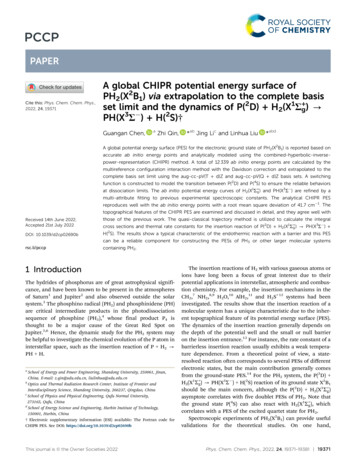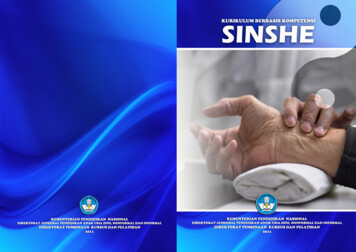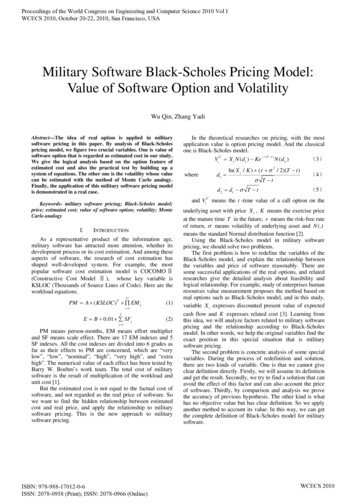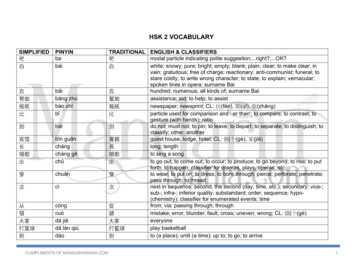
Transcription
PCCPPAPERCite this: Phys. Chem. Chem. Phys.,2022, 24, 19371A global CHIPR potential energy surface ofPH2(X2B1) via extrapolation to the complete basisset limit and the dynamics of P(2D) H2(X1R g) PH(X3R ) H(2S)†Guangan Chen,aZhi Qin,*ab Jing Lic and Linhua Liu*abdA global potential energy surface (PES) for the electronic ground state of PH2(X2B1) is reported based onaccurate ab initio energy points and analytically modeled using the combined-hyperbolic-inversepower-representation (CHIPR) method. A total of 12 339 ab initio energy points are calculated by themultireference configuration interaction method with the Davidson correction and extrapolated to thecomplete basis set limit using the aug-cc-pV(T d)Z and aug-cc-pV(Q d)Z basis sets. A switchingfunction is constructed to model the transition between P(2D) and P(4S) to ensure the reliable behaviors3 at dissociation limits. The ab initio potential energy curves of H2(X1S g ) and PH(X S ) are refined by amulti-attribute fitting to previous experimental spectroscopic constants. The analytical CHIPR PESreproduces well with the ab initio energy points with a root mean square deviation of 41.7 cm 1. Thetopographical features of the CHIPR PES are examined and discussed in detail, and they agree well withReceived 14th June 2022,Accepted 21st July 2022those of the previous work. The quasi-classical trajectory method is utilized to calculate the integral3 cross sections and thermal rate constants for the insertion reaction of P(2D) H2(X1S g ) - PH(X S ) DOI: 10.1039/d2cp02690bH(2S). The results show a typical characteristic of the endothermic reaction with a barrier and this PESrsc.li/pccpcontaining PH2.can be a reliable component for constructing the PESs of PH3 or other larger molecular systems1 IntroductionThe hydrides of phosphorus are of great astrophysical significance, and have been known to be present in the atmospheresof Saturn1 and Jupiter2 and also observed outside the solarsystem.3 The phosphino radical (PH2) and phosphinidene (PH)are critical intermediate products in the photodissociationsequence of phosphine (PH3),4 whose final product P4 isthought to be a major cause of the Great Red Spot onJupiter.5,6 Hence, the dynamic study for the PH2 system maybe helpful to investigate the chemical evolution of the P atom ininterstellar space, such as the insertion reaction of P H2 PH H.aSchool of Energy and Power Engineering, Shandong University, 250061, Jinan,China. E-mail: z.qin@sdu.edu.cn, liulinhua@sdu.edu.cnbOptics and Thermal Radiation Research Center, Institute of Frontier andInterdisciplinary Science, Shandong University, 266237, Qingdao, ChinacSchool of Physics and Physical Engineering, Qufu Normal University,273165, Qufu, ChinadSchool of Energy Science and Engineering, Harbin Institute of Technology,150001, Harbin, China† Electronic supplementary information (ESI) available: The Fortran code forCHIPR PES. See DOI: https://doi.org/10.1039/d2cp02690bThis journal is the Owner Societies 2022The insertion reactions of H2 with various gaseous atoms orions have long been a focus of great interest due to theirpotential applications in interstellar, atmospheric and combustion chemistry. For example, the insertion mechanisms in theCH2,7 NH2,8,9 H2O,10 AlH2,11 and H2S 12 systems had beeninvestigated. The results show that the insertion reaction of amolecular system has a unique characteristic due to the inherent topographical feature of its potential energy surface (PES).The dynamics of the insertion reaction generally depends onthe depth of the potential well and the small or null barrieron the insertion entrance.13 For instance, the rate constant of abarrierless insertion reaction usually exhibits a weak temperature dependence. From a theoretical point of view, a stateresolved reaction often corresponds to several PESs of differentelectronic states, but the main contribution generally comesfrom the ground-state PES.14 For the PH2 system, the P(2D) H2(X1S g) - PH(X3S ) H(2S) reaction of its ground state X2B1should be the main concern, although the P(2D) H2(X1S g)asymptote correlates with five doublet PESs of PH2. Note thatthe ground state P(4S) can also react with H2(X1S g), whichcorrelates with a PES of the excited quartet state for PH2.Spectroscopic experiments of PH2(X2B1) can provide usefulvalidations for the theoretical studies. On one hand,Phys. Chem. Chem. Phys., 2022, 24, 19371–19381 19371
Paperexperiments presented the spectroscopic constants of PH2(X2B1),such as the bending vibration frequency o2 and symmetricalstretching vibration frequency o1, which were obtained byanalyzing the absorption spectra of the bending vibration15–17and symmetrical stretching vibration.17–19 The latest experimental vibration frequencies of PH2(X2B1) were measured byJakubek et al.17 with the values of o1 2298 cm 1 and o2 1102 cm 1. On the other hand, experiments obtained theequilibrium geometries of the electronic state PH2(X2B1),20–23which were deduced from the observed vibronic bands of theA2A1–X2B1 transition. The recent results were RPH 1.4178 Å andyHPH 91.691 for the X2B1 state and RPH 1.4059 Å and yHPH 120.991 for the A2A1 state,22 respectively. In addition, experiments also produced the dissociation energy D0. For HP–H, itwas estimated to be 74.2 2 kcal mol 1.24For theoretical studies, several attempts were made tocalculate the equilibrium geometry of PH2.25–29 In particular,Woodcock et al.28 calculated the equilibrium geometry for thethree lowest-lying electronic states of PH2 at 44 different levelsof theory and presented accurate geometries of the X2B1 andA2A1 states. The D0(HP–H) of PH2(X2B1) - PH(X3S ) H(2S)was calculated to be 72.2 kcal mol 1,30 which agrees well withthe measured value.24 Meanwhile, Kayi et al.29 obtained thegeometry and bending vibrational frequency of the linearground state of PH2(2Pu), which was found to be a transitionstate in our work. However, the analytical PESs for the electronicstates of PH2 had not been investigated in the above-mentionedstudies.The first analytical PESs of the X2B1 and A2A1 states of PH2were constructed by Jakubek et al.17 and the two PESs showed areasonable Renner–Teller degeneracy at the HPH collinearconfiguration. Subsequently, Yurchenko et al.31 utilized thesePESs to compute the rotation–vibration structure of PH2. ThesePESs were constructed using 210 energy points in the vicinity ofthe equilibrium geometry of PH2. Zhang et al.32 presented ananalytical PES of PH2(X2B1) without consideration of the conical intersection in the P(2D) H2(X1S g) channel. For accuratestudies of the reaction dynamics, an analytically modeledglobal PES is required, so as to describe the relevant topologicalfeatures, such as dissociation limits, barriers on the entrancechannel, etc. Also, there has not been a dynamic study ofP(2D) H2(X1S g) - PH(X3S ) H(2S) reported.In this work, the main purpose is to construct a global PESfor the ground state PH2(X2B1), so as to carry out a tentativestudy of P(2D) H2(X1S g) - PH(X3S ) H(2S). The energypoints of PH2(X2B1) were calculated by the state-of-the-artab initio methods, along with the basis set extrapolation tothe complete basis set (CBS) limit. The CBS energies were thenused to fit the analytical functional form of combinedhyperbolic-inverse-power-representation (CHIPR)33 based onthe many-body expansion (MBE)34,35 theory. The CHIPRmethod was proposed by Varandas33 and recently developedby Rocha et al.36–38 and Xavier et al.39–41 The CHIPR two-bodyfragments of H2(X1S g) and PH(X3S ) were refined by previousexperimental spectroscopic constants. The obtained CHIPRPES was introduced to the quasi-classical trajectory (QCT)19372 Phys. Chem. Chem. Phys., 2022, 24, 19371–19381PCCPmethod42,43 to compute the integral cross section and thermalrate constants of P(2D) H2(X1S g) - PH(X3S ) H(2S). It isworth mentioning that there exists a small barrier in theentrance of the PES for the ground state NH2(X2B1) and theelectronic structure of PH2(X2B1) resembles that of NH2(X2B1).Therefore, the PES of the ground state PH2(X2B1) may havesimilar topographical features to NH2(X2B1), and P(2D) H2(X1S g) - PH(X3S ) H(2S) is expected to become anothertypical case of the insertion reaction with a barrier.The remaining part of this paper proceeds as follows. Thedetails of ab initio calculation and CBS extrapolation arepresented in Section 2. Section 3 expatiates each step for fittingthe CHIPR PES of PH2(X2B1). The topographical features of theCHIPR PES are discussed in Section 4 and the QCT calculationsare reported in Section 5. Finally, the concluding remarks aredrawn in Section 6.2 Ab initio calculations andCBS extrapolationAb initio energy points of the ground state PH2(X2B1)were obtained using the MOLPRO 2015 software package44,45with the Cs(A00 ) symmetry point group. The calculations werecarried out as follows. Firstly, the single-configuration wavefunction of PH2(X2B1) was generated by the Hartree–Fock (HF)method. Then, the full-valence complete active space selfconsistent field (CASSCF) method46 was applied to obtainmulti-configuration wavefunctions based on the HF wavefunction. In the CASSCF calculations, 11 active molecular orbitals(9A 0 2A00 ) and 5 closed core orbitals (4A 0 1A00 ) were considered.Finally, using the CASSCF wavefunctions as a reference, thedynamic correlation energies were computed by the internallycontracted multireference configuration-interaction methodincluding the Davidson correction [MRCI(Q)].47,48 During ab initiocalculations, the Dunning-type basis sets49–51 aug-cc-pV(X d)Z(X T, Q) and aug-cc-pVXZ (X T, Q) were selected for the P atomand H atom, respectively. For convenience, they are referred to asAVTdZ and AVQdZ, respectively.A total of 12 339 ab initio energy points were distributed intwo major structures of Jacobi coordinates. In the P–H2 channel,the grids are defined by 1.4 r RH–H/a0 r 6, 1.6 r rP–HH/a0 r11.0, and 0 r gP–HH/deg r 901. In the H–PH channel, the rangesare defined by 1.6 r RP–H/a0 r 5, 1.6 r rH–PH/a0 r 11.0, and0 r gH–PH/deg r 1801. Also, the grids in the vicinity of theequilibrium geometry and transition states were constructed tobe dense enough. The MRCI(Q)/AVTdZ and MRCI(Q)/AVQdZenergies were used to extrapolate to the CBS limit. The completeactive space (CAS) energies and dynamic correlation (dc) energies were extrapolated separately due to the distinct convergencerates, given byEX ECAS Edc(1)where the subscript X represents the basis set. The CASenergies were extrapolated using a two-point extrapolationprotocol developed by Karton and Martin,52 i.e.,This journal is the Owner Societies 2022
PCCPPaperlECAS ECASXN B/X(2)where l 5.34 is an effective decay parameter. While the dcenergies were obtained using the Varandas uniform singletand triplet-pair extrapolation:53A3A5dcEXdc ðRÞ ¼ E1ðRÞ þþ3ðX þ bÞðX þ bÞ5(3)applied. The distributed origins Rrefp,a are related by the followingexpression:33ref a 1Rrefp,a z(Rp )where the parameters z and Rrefp should be reasonably chosenduring the fitting.3.1A5 A5(0) cA35/4(4)where the predefined constants A5(0), c and b are chosen as0.0037685459 Eh, 1.17847713 Eh 5/4 and 3/8, respectively.3 The CHIPR potential energy surfaceIn the CHIPR method,33,36,37 the PES of a triatomic moleculeassumes the MBE34,35 form:V¼3Xð1ÞVAi þ3X ð2Þ ð3ÞVAi Aj Rij þ VA1 A2 A3 ðR12 ; R13 ; R23 Þ(5)iaji¼1where V(1) is the one-body fragment of each atom, V(2) is thetwo-body fragment in each dissociation scheme and V(3) is thethree-body fragment. Generally, the zero of energy is chosenwith all atoms far away from each other, and V(1) is non-zeroonly when the excitation of the atomic state exists in thedissociation scheme (see Section 3.1 for details).Considering the permutational symmetry for an n-atomsystem, the CHIPR n-body term has the following form:36,37"#LtXYi(6)V ðnÞ ¼Ci ;.;it P ypp1i1 ¼0;.;it ¼0MXca fp;aOne-body fragment and switching functionAccording to the spin-spatial Wigner–Witmer correlation rules,the dissociation scheme of the ground state PH2(X2B1) can bedescribed by8 2 H S þ PH X3 S PH2 X2 B1 ! P 2 D þ H2 X1 Sgþ(11) :P 4S þ H 2S þ H 2SThe diatomic molecules PH(X3S ) and H2(X1S g) dissociateto their ground-state P(4S) and H(2S) atoms, while the excitedstate P(2D) atom appears in the P(2D) H2(X1S g) channel, asshown in Fig. 1. For an adiabatic PES of PH2(X2B1) dissociatingto P(4S) H(2S) H(2S), it is necessary to construct a function tofulfill the smooth transformation between P(2D) and P(4S).Here, we adopted a switching function presented by Varandas.8This function is widely used to model the correct transformationbetween excited- and ground-state atoms and to construct manyPESs of triatomic molecules, such as NH2(X2B1),8 H2S (X2A00 ),12N2O(X1S ),62 etc. In this case, the one-body term can be written asX ð1Þð1Þð1ÞVA ¼ VPð2 DÞ f ðRÞ ¼ VPð2 DÞ hðR1 Þgðr1 Þ(12)Að1Þwhere VPð2 DÞ is the excitation energy of P(2D), R1 is the bondp¼1where Ci1,. . .,it are expansion coefficients for a Lth-order polynomial, P̂ is the operator which ensures the permutationalsymmetry, yp are basis sets of coordinates (p 1, 2,. . .,t) forthe reference geometry and t is the total number of internaldegrees of freedom. yp can be expanded by the distributedorigin contracted basis set:33yp ¼(10)length of HH and r1 is the distance between P and the center of(7)a¼1where ca are the contraction coefficients, and a denotes eachprimitive function fp,a. The primitive function generally hasone of the two following forms:33fp,a sechZa(gp,arp,a)(8)andfp;a s tanh ba Rp a¼Rp sechZa gp;a rp;a(9)where gp,a are non-linear parameters, rp,a Rp Rrefp,a representsthe deviation of the coordinate Rp from the primitive origin Rrefp,a,and the parameters Za, sa and ba are set to be values of 1, 6 and1/5,33 respectively. It is worth noting that eqn (9) is used whenthe long-range terms are considered, otherwise, eqn (8) isThis journal is the Owner Societies 2022Fig. 1 The transition from P(2D) to P(4S) between the P(2D) H2 channeland the P(4S) H H channel. The solid line is obtained from the CHIPRPES. Points are the CBS energies extrapolated by the MRCI(Q)/AVTZ andMRCI(Q)/AVQZ energies.Phys. Chem. Chem. Phys., 2022, 24, 19371–19381 19373
PaperPCCPFig. 2 The switching function for smoothing the CHIPR PES of theground state PH2(X2B1).mass of HH. h(R1) is used to adjust the transition from P(2D) toP(4S) between the P(2D) H2 channel and the P(4S) H Hchannel, given by8hðR1 Þ ¼2 nh io1Xi1 3þb(13)1 tanh ai R1 Ri0R R1i114 i¼1where the parameters ai, bi, R01i and R11i (i 1, 2) were obtained bythe least-square fitting to 24 CBS energy points, i.e., the bluepoints shown in Fig. 2. The CBS energies were extrapolated by theMRCI(Q)/AVTZ and MRCI(Q)/AVQZ energies. As shown in Fig. 1,h(R1) controls the decay from P(2D) to P(4S) with the increasingHH bond length, while keeping r1 fixed at 10 a0. The amplitudefunction g(r1) is introduced in eqn (12) to annihilate h(R1) at shortdistances of r1 (see Fig. 2), and thus to achieve a smooth andreliable PES, given by8gðr1 Þ ¼ 11 þ tanh a0 r1 r012(14)where a0 and r01 are chosen to be 0.75 and 5.5, respectively, asð1Þsuggested by Varandas.8 The calculated VPð2 DÞ is 11361.81 cm 1,which agrees well with that of 11370.78 cm 1 obtained by summingover the weighted average energy of the P(2D3/2) and P(2D5/2) states(i.e. 11361.02 cm 1 and 11376.63 cm 1, respectively) from theAtomic Spectra Database of National Institute of Standards andTechnology.63 It can be seen in Fig. 1 that there exists an avoidcrossing located near R1 3.4 a0, which is well reproduced in thiswork. The parameters of switching function are collected in theESI.†3.2Two-body fragmentIn the CHIPR method, the two-body fragment is given in termsof eqn (6) by considering the Coulomb interaction, given by33,36V ð2Þ ðRÞ ¼LZA ZB XCk ykR k¼1(15)where ZA and ZB are the nuclear charges of the A and B atoms,respectively. According to eqn (5) and (11), the two-bodyfragments of the ground states H2(X1S g) and PH(X3S ) arerequired. Their ab initio energy points were computed at theMRCI(Q)/aug-cc-pwCV5Z-DK level of theory. During the fitting,19374 Phys. Chem. Chem. Phys., 2022, 24, 19371–19381Fig. 3 (a) The PECs of PH(X3S ) and H2(X1S g ). Solid lines are the PECsfitted by the CHIPR form of eqn (6). Open circles are the ab initio energypoints. (b) The deviations between ab initio energies and the corresponding energies from the unrefined CHIPR PECs. (c) The errors ofvibrational level energies between previous measured values and thoseobtained from the experimentally-refined PECs.M of the contracted bases in eqn (7) was chosen to be 4 and L ofthe polynomial expression in eqn (15) was chosen to be 8 foreach two-body fragment. Fig. 3(a) shows the fitting CHIPR PECsof H2(X1S g) and PH(X3S ), in which the root mean squaredeviation (RMSD) is 0.17 cm 1 and 0.93 cm 1, respectively.Fig. 3(b) presents the deviations between ab initio energies andfitted energies, which are within 3 cm 1. As shown, theobtained PECs of H2(X1S g) and PH(X3S ) exhibit smooth andreasonable behaviors in both long and short internuclearranges and the CHIPR method reproduces well with theab initio results.According to eqn (5), the three-body fragment will vanish aslong as an atom moves away from the other two atoms. For thePES of PH2(X2B1), the configurations of P–H2 and H–PH dependgreatly on the two-body fragments. Also, the diatomic moleculeacts as the reactant or product and the high-precision two-bodyfragments can correctly reproduce the initial and final states ofthe reaction. Therefore, we used the experimental spectroscopicconstants,55,57–59 including equilibrium geometries, dissociation energies, vibrational frequencies (in Table 1) and theenergies of vibrational levels v (in Table 2) to refine the PECsof H2(X1S g) and PH(X3S ). A total of 14 measured vibrationallevels for H2(X1S g)59 and 5 measured vibrational levels forPH(X3S )57 were adopted during the refining process. Therefining process was carried out in the CHIPR 4.0 program37and the LEVEL program64 was used to calculate the vibrationallevel energies of our PECs. The spectroscopic constants andvibrational level energies of the refined H2(X1S g) and PH(X3S )PECs are also listed in Tables 1 and 2, respectively. Fig. 3(c)prints the errors between our refined vibrational level energiesand the measured values, which are within 0.2 cm 1. Therefined vibrational level energies also agree well with thosecalculated by Roueff et al.60 and Langleben et al.,61 whose dataare included in the Strasbourg astronomical Data Center.65Hence, the two-body fragments of our CHIPR PES for H2(X1S g)and PH(X3S ) are accurate and reliable. The coefficients of therefined H2(X1S g) and PH(X3S ) PECs are displayed in the ESI.†This journal is the Owner Societies 2022
PCCPPaperTable 1 The spectroscopic constants of the CHIPR two-body fragments,along with previous theoretical and experimental resultsMethodReaDeboe coewecaecBecH 2 (X 1 S g )CHIPRdCHIPReTheory 3962.9453.1623.06262.92660.79260.82660.853PH(X3S )CHIPRdCHIPReTheory 0.2568.5178.5538.5348.539i0.253iaThe equilibrium geometry, a0. b The dissociation energy, eV. c Theunits of oe, oewe, ae and Be are cm 1. d The CHIPR PECs fitted by theab initio energies. e The experimentally-refined CHIPR PECs via multiproperty fit to the experimental spectroscopic constants. f Results at theMRCI/AV6Z level from Ynag et al.54 g Ref. 55. h Results at the MRCI(Q)/AV5Z level from Gao et al.56 i Results obtained by Fourier transforminfrared emission spectroscopy from Ram and Bernath.57 j Ref. 58.Table 2 The energies (cm 1) of vibrational levels (v) for the refined CHIPRtwo-body fragments, along with previous theoretical and experimentalresultsPH(X3S )H2(X1S 1222105.5522940.59aResults obtained by flash discharge spectra from Dabrowski.59Results obtained by nonadiabatic perturbation theory from Roueff et al.60cResults obtained from the experimentally-refined CHIPR PECs. d Resultsobtained by Fourier transform infrared emission spectroscopy from Ramand Bernath.57 e Results at the MRCI(Q)/AV5Z level from Langleben et al.61b3.3Three-body fragmentOnce the switching function and two-body fragments aredetermined, the three-body energies e(3)(R) can be obtained byeð3Þ ðRÞ ¼ EðRÞ 3Xð2Þð1ÞVi ðRi Þ VPð2 DÞ hðR1 Þgðr1 Þ(16)Table 3PESStratified root-mean-square deviations (RMSDs) of the CHIPREnergyaNbMax 0276532213627401144885048590370518320891010 90711 44712 24712 913531632178121492335248124934RMSDThe energy range, kcal mol 1. b The number of energy points in thecorresponding range. c The units of maximum deviation and RMSDare cm 1. d The number of energy points with a deviation larger thanthe RMSD.awhere Ci,j,k are expansion coefficients. Also, Ci,j,k should satisfythe general constraints, i.e., i j k a i a j a k and i j k r L(see Rochas work for details36). To avoid unphysical holes athigh-energy interaction regions, eqn (17) is multiplied by adamp function:33,37"#x31Yð3ÞD ðRÞ ¼(18)f1 þ tanh½kðRi R0 Þ g8 i¼1where R0 0.6 a0, k 30 a0 1 and x 10. This damp functionensures that the three-body fragment gradually disappears as theconfiguration approaches the high-energy interaction regions.During the fitting of the three-body fragment, M of thecontracted bases in eqn (7) was chosen to be 4 and L of thepolynomial expression in eqn (17) was chosen to be 14. Table 3lists the accumulated RMSD with respect to the ascendingordered CBS energies. A total of 12 339 CBS energies wasutilized in the nonlinear least-square fitting procedure, coveringan energy range up to about 1700 kcal mol 1 above the globalminimum of PH2(X2B1). As expected, the CHIPR PES reproducesthe ab initio energy points well near the equilibrium geometry ofPH2(X2B1). For the remaining configurations, it also provides asurprising fitting accuracy, especially for the high-energy points.The results show a high fitting accuracy with a total RMSD of41.7 cm 1 (or 0.119 kcal mol 1). The coefficients of the threebody fragment are displayed in the ESI.†4 Features of CHIPR PESi¼1where E(R) is the relative energy of a triatomic molecule, i.e.,the CBS energy relative of PH2(X2B1) to its P(4P) H(2S) H(2S)asymptote. In the CHIPR method, the three-body fragment hasthe following form:36()g2GLXX ð3Þði;j;kÞ i j k(17)V ðRÞ ¼Ci;j;kPgy1 y2 y3i;j;k¼0gThis journal is the Owner Societies 2022Topographical features of the CHIPR PES for the ground statePH2(X2B1) are shown in Fig. 4 and 5, which display theimportant stationary points, namely the global minimum(GM), transition state (TS), second-order saddle (SP) and localminimum (MIN). Table 4 presents the main attributes of thestationary points on the CHIPR PES, including the potentialenergies (E) relative to the P(4S) H(2S) H(2S) asymptote, theinteratomic distances for HH (R1) and PH (R2 and R3), the HPHPhys. Chem. Chem. Phys., 2022, 24, 19371–19381 19375
Paperbond angle (y), the dissociation energy D0(HP–H) and thevibration frequencies, including the symmetrical stretchingo1, bending o2 and antisymmetric stretching o3. Table 4 alsocollects the geometry optimization (OPTG)66 results for GM,TS1 and TS2 as implemented in MOLPRO 2015.44,45Fig. 4(a) presents the contour map of PH2(X2B1) for the PHbond stretching in the HPH bending configuration with y fixedat 92.091. It can be seen that the GM of the C2v symmetry locatesat R1 3.860 a0 and R2 R3 2.681 a0, which are also given in Fig.4(d) and 5(b). The corresponding dissociation energy D0(HP–H)is computed to be 77.435 kcal mol 1 and the vibrational frequencies are 2385 cm 1, 1072.83 cm 1 and 2395.69 cm 1 for o1,o2 and o3, respectively. As shown in Table 4, the attributes ofGM are very similar to those from our OPTG at the MRCI(Q)/AV6Z level and those from the previous theoretical resultscalculated at the CISD/VQZ level28 and RECP/MRSDCI level.30The attributes also agree well with the measured ones shown inTable 4, but the o1 values from all of the four theoretical studiesare about 100 cm 1 larger than that of the measurement.17Although the P atom could possibly be better simulated usingPCCPthe ECP10MWB basis set,67 no attempt has been made due tothe unaffordable computational costs.Fig. 4(b) and(c) display the contour plots for bond stretching inthe HPH and PHH collinear configurations, respectively. As shownin Fig. 4(b), a transition state (TS1) is found to locate at R1 5.228a0 and R2 R3 2.614 a0 with DNh symmetry, connected with thesymmetrically distributed second-order saddle points (SP1). Thestationary points TS1 and SP1 are associated to the linear 2Pstructure of PH2 where the X2B1 and A2A1 Renner–Teller statesbecome degenerate. As shown in Table 4, the attributes of TS1 aresimilar to those from our OPTG at the MRCI(Q)/AV6Z level andthose calculated by Kayi et al.29 at the CASSCF/AVTZ level. Fig. 4(d)shows the contour plot for the C2v insertion of the P atom into theH2 fragment, which exhibits GM, TS1 and another transition state(TS2) of C2v symmetry. The transition state TS2 is found to belocated at R1 1.413 a0 and R2 R3 4.992 a0, which has aprofound effect on the insertion reaction of P(2D) H2(X1S g).Hence, the OPTG were carried out for TS2 at the MRCI(Q)/AV5dZand MRCI(Q)/AVQdZ level to validate the attributes of TS2 on ourfitted CHIPR PES, which shows an excellent agreement.Fig. 4 (a) The contour plot for bond stretching in the HPH bending configuration with y fixed at 92.091. (b) The contour plot for bond stretching inthe HPH collinear configuration. (c) The contour plot for bond stretching in the PHH collinear configuration. (d) The contour plot for the C2v insertionof the P atom into the H2 fragment. Contours are equally spaced by 0.01 Eh, starting from 0.24 Eh for panels (a) and (d), 0.13 Eh for panel (b), and 0.105 Eh for panel (c).19376 Phys. Chem. Chem. Phys., 2022, 24, 19371–19381This journal is the Owner Societies 2022
PCCPPaperFig. 5 illustrates the long-range behavior of the CHIPRPES, so as to provide a reliable description of the van derWaals configuration and the associated transition state. Thebrown band shown in Fig. 5(a) reveals that a barrier exists inthe entrance channel of the P(2D) H2(X1S g) system for allinteratomic orientations and its weakest configuration is TS2.It also shows a van der Waals minimum (the MIN in Table 4) ofC2v symmetry, which connects TS2 and the P(2D) H2(X1S g)dissociation limit. This connecting path demonstrates that theinsertion of the P atom along the mid-perpendicular of the HHbond is relatively easy to cross the barrier around H2, resultingin the relevant reaction. On the contrary, Fig. 5(b) implies thatthe H(2S) PH(X3S ) reaction is a barrierless insertion reactionfor most interatomic orientations.To better view the major topographical features, a relaxedtriangular contour plot68 for the CHIPR PES is displayed inFig. 6 based on the scaled hyperspherical coordinates (b* b/Qand g* g/Q), given by0Fig. 5 (a) The contour plot for P moving around H2 with R1 fixed at 1.401 a0.Contours are equally spaced by 0.002 Eh, starting at 0.15 Eh. Dashed areasare contours equally spaced by 0.000025 Eh, starting at 0.1229 Eh. (b) Thecontour plot for H moving around PH with R2 fixed at 2.681 a0. Contours areequally spaced by 0.01 Eh, starting at 0.24 Eh. Dashed areas are contoursequally spaced by 0.0005 Eh, starting at 0.12 Eh.Table 4101B C BpffiffiffiB C B3Bb C ¼ B0@ A @g2 1Q110 2 11R1BCpffiffiffi CCB 2 C 3 CB R2 CAA@ 1R32(19)As shown in Fig. 6, the locations and symmetries of allstationary points for the ground-state PH2(X2B1) are illustratedexplicitly. The CHIPR PES of the ground-state PH2(X2B1) exhibits a smooth and reasonable behavior. The critical equilibriumAttributes for the stationary points of the PH2(X2B1) CHIPR PESE/EhR1/a0R2/a0R3/a0y/dego1/cm 1o2/cm 1o3/cm 1D0a (HP–H) 0.2460 4.091121.5111252395.692394.67240477.43578.0002295 15 f2298 3i1101.98g1102 76.01i325.04i2726.932629.4 0.1211 0.1213 0.12055.2285.2525.2541.4131.4151.416Second-order saddleCHIPRSP1(CNv)CHIPRSP2(CNv) 0.1047 1.091998.62931.93i1060.13i1458.28iLocal minimumCHIPRMIN(C2v) lobal sition VQdZba 0.1335 0.1320 1 b72.274.2 2j549.96578.09402.21The unit of D0(HP–H) is kcal mol . Results from the geometry optimization. Results at the CISD/VQZ level from Woodcock et al.28 d Resultsat the RECP/MRSDCI level from Balasubra
set limit and the dynamics of P(2D) H 2(X 1R g) - PH(X3R ) H(2S)† Guangan Chen, a Zhi Qin, *ab Jing Lic and Linhua Liu *abd A global potential energy surface (PES) for the electronic ground state of PH 2(X 2B 1) is reported based on accurate ab initio energy points and analytically modeled using the combined-hyperbolic-inverse-power-representation (CHIPR) method. A total of 12339 ab .










